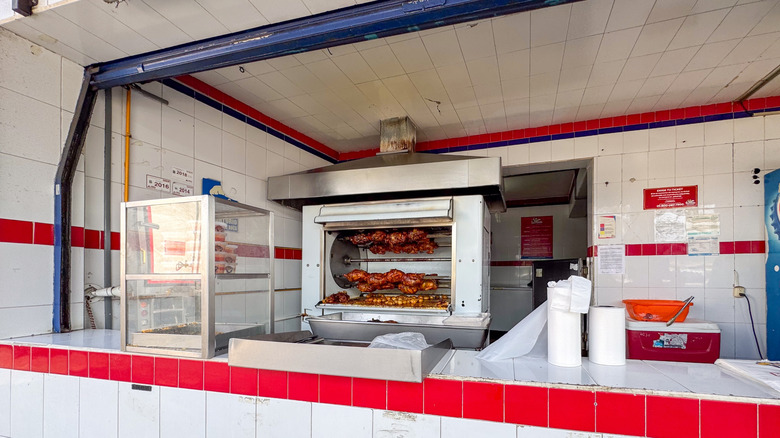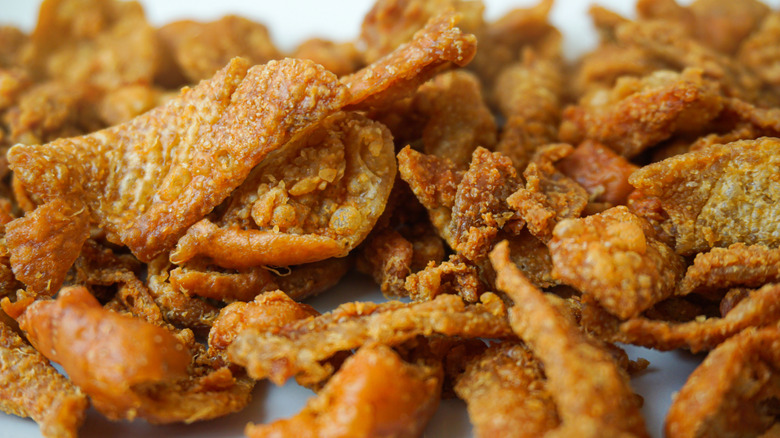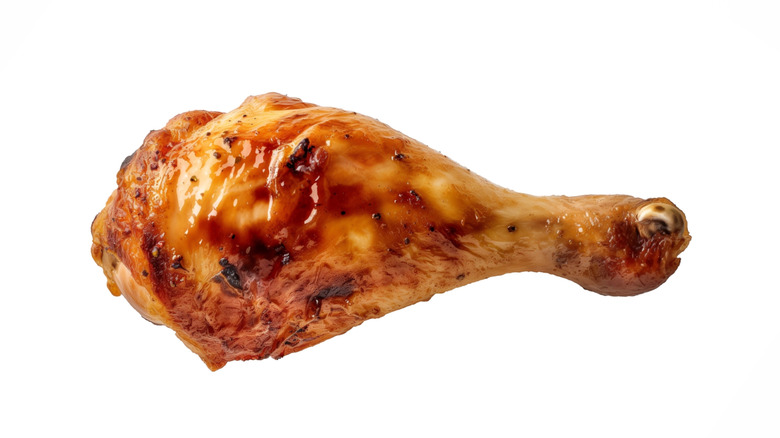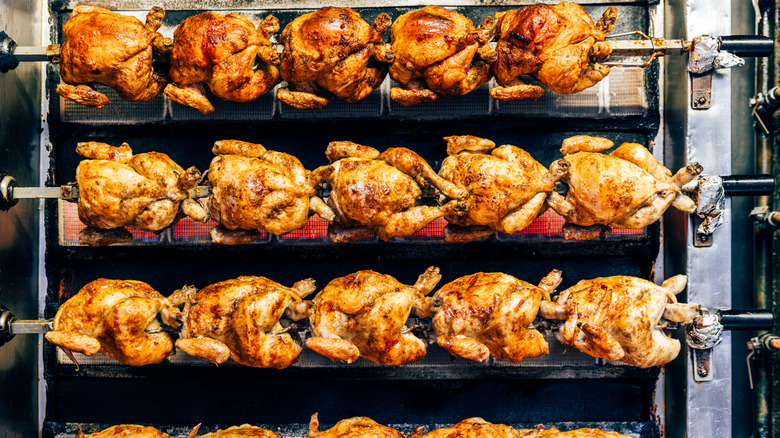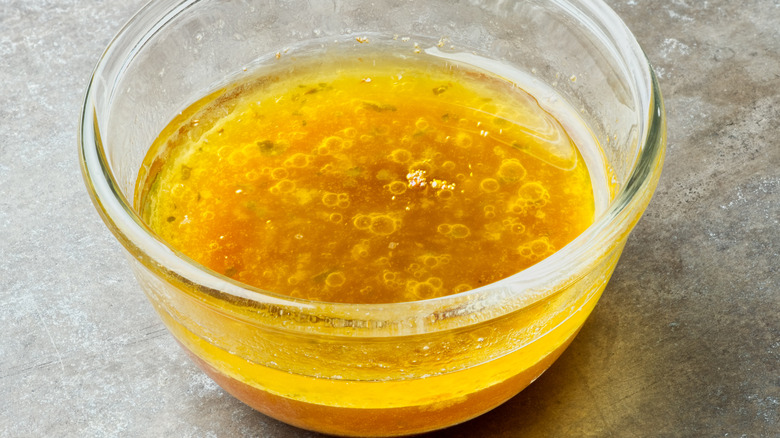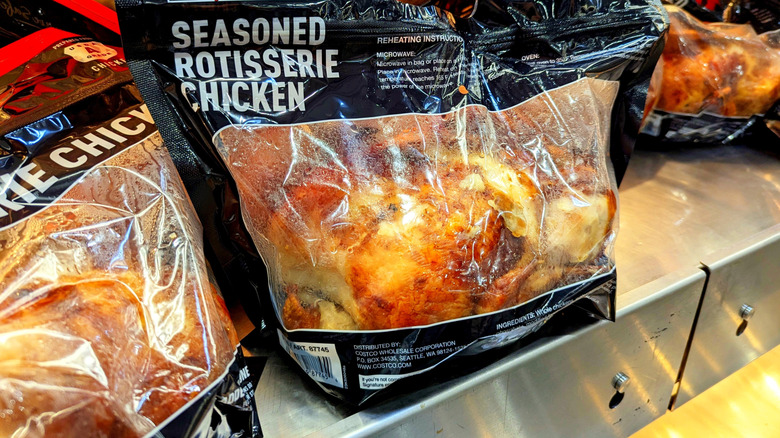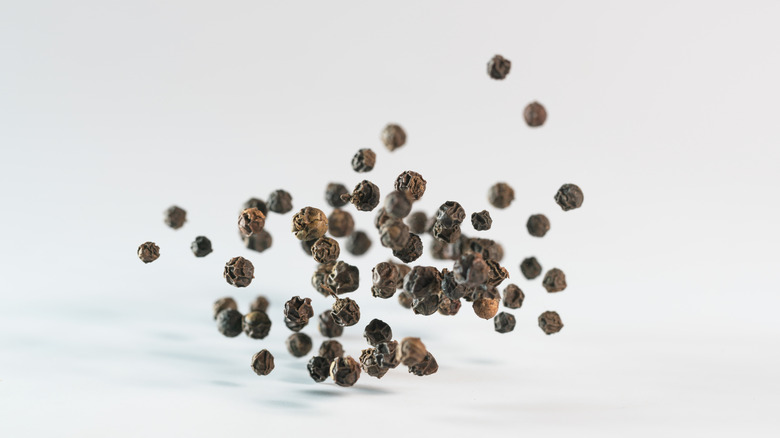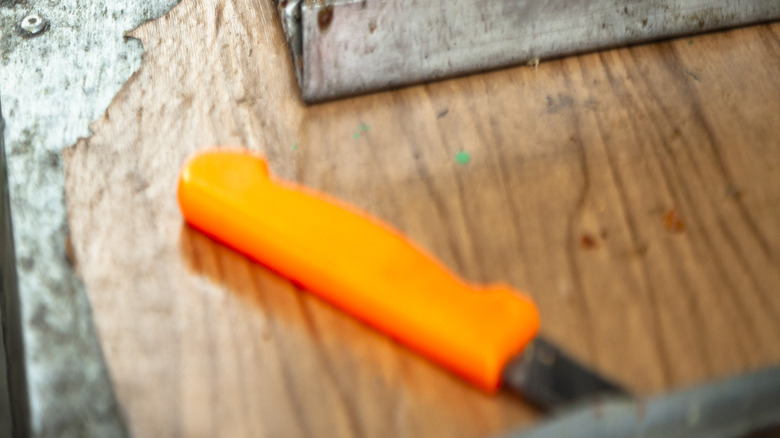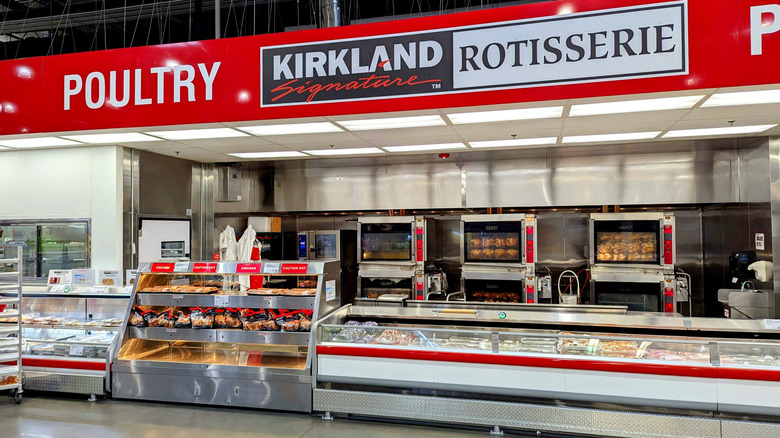12 Signs You Shouldn't Buy That Rotisserie Chicken
We may receive a commission on purchases made from links.
If you're an omnivore, then chances are you know the appeal of the rotisserie chicken all too well. It's perfect for saving dinner at the end of a stressful day. Not only is it nice to get a hot bird, but there are a number of useful ways to use leftover rotisserie chicken, from turning chicken meat into some of the best sandwiches to making an easy homemade broth.
However, rotisserie chickens vary a lot in quality, and there's a definite difference between the best and worst grocery store options of these birds. There are debates about which brand makes the best rotisserie chicken, from Costco to Whole Foods and beyond. (Psst ... our reporting has found that you're better off going the Kirkland Signature rotisserie chicken route.) So, how do you know which ones you should choose, and which you should avoid? Glad you asked: Here are 12 signs you shouldn't buy that rotisserie chicken.
The chicken is a funny color
Gray or green patches are a bad sign on raw chicken, and the same is true on cooked chicken. The skin should be golden-brown, while the meat should be a light whitish-pink. Ideally, it's good to note that if the store did its job well, you won't see any meat because the skin will be fully intact. But the bottom line is if you see any color changes whatsoever, avoid that chicken. Ditto spots that look like mold, though that almost never happens at the store — that's more a consequence of leaving it too long in your fridge.
Note that when you buy a seasoned chicken that has speckled skin and a lot of color variation, it can be harder to spot color changes. So while you're at the store, check the bird over carefully. Once you get it home, make sure to eat it within three days, as otherwise you may miss the signs of an incipient bacterial infection and get sick.
There is one exception to the color rule, and that has to do with green flesh. Although this doubtless sounds like the most disgusting condition of all, it's not as bad as you think. Green breast, officially termed ischemic myopathy, is a condition that occurs when chicken and turkey breasts grow too large for the blood supply to support them, so some of the muscle tissue begins to die. It is not a food safety risk, but it is kind of gross.
Skin looks dull or slimy
Freshly cooked chicken skin should be shiny and greasy, not dull or slimy. If it looks like it has weird patches of goo or if it has a bizarre sheen that doesn't look like grease, don't buy it; slime is often a sign of spoilage. The correct color of well-cooked skin is deep golden-brown, and anything lighter may indicate inadequate cooking or some kind of safety issue.
Less worrisome but of more culinary importance, dull skin may simply mean that your chicken was too wet when it was cooked. That will prevent it from crisping and browning adequately, which will affect the flavor somewhat, as a lot of the rich, umami taste of chicken comes from the Maillard reaction that causes browning. If that doesn't happen, your bird will be much blander.
Since the whole point of a rotisserie bird is to take something tasty home with no extra work required, this really defeats the whole purpose of buying one. Of course, being in an enclosed container or bag is going to steam the chicken a little, which will counteract crispiness, and there's not much you can do about that. But if the skin isn't a beautiful golden-brown, avoid it.
The chicken's skin is super wrinkled
A rotisserie chicken should have taut skin that shows firm, plump meat underneath. Tight skin ensures even coverage of the meat, which makes it likelier that the chicken will be moist and flavorful. If the skin is wrinkled, baggy, or deflated-looking, that means the chicken has been sitting around for a long time and has probably dried out; as the juices leave the bird under the heat, the skin wrinkles to accommodate the shrinking bird.
Will this kill you? No. Is it gross? Not particularly. But will you enjoy the chicken as much as one with tighter skin? Probably not. Especially if you plan to eat pieces of chicken right off the bird, rather than putting the meat in a soup or salad, you want the nicest result, and that means tight skin.
The chicken is too light for its size
Again, this is a test of juiciness. When you pick up chicken, it should feel heavy enough for its size or even heavier. That means it still has plenty of juices inside the meat, which is what makes it moist (or, if you're super-averse to dry meat like this writer, edible). When chickens sit around under the heat lamp too long, a lot of those juices evaporate due to continued cooking, which can lead to undesirable results as well as a lighter-feeling bird.
Most whole chickens are between 4 and 5 pounds, so they should have some heft to them. It's not crazy to pick up every option and weigh it in your hands to see how it feels. Also, due to the drying issue, you can safely ignore the poundage on the label, as it may have changed while the chicken was sitting around under the lamps. If you can, go for a rotisserie chicken option that's on display behind the meat counter. This indicates the store has nothing to hide and is giving you the freshest option.
There's no juice at all at the bottom
Rotisserie chickens get drier the longer they sit at the grocery store because they're kept warm under the heat lamp. While some of that is to be expected, it's a bad sign if there are no juices at the bottom of the container, which means there wasn't much moisture to begin with. Good rotisserie chickens produce lots of drippings as the fat and meat juices render, which is part of their appeal: Juices from the chickens above baste the ones below as the rack turns, and so the cycle goes.
Anyone who has ever pulled a hot chicken from the oven knows that it continues to produce drippings even as it cools. (That's why turkey carving boards always have grooves in them: to collect the juices.) Thus, you should see some sign of those drippings in the container, yet consumer reporting has shown many complaints about dry chickens. You can avoid a similar experience by a brief scout of the bottom of the bag or container.
Too much juice is pooling at the bottom
On the opposite side of the spectrum, you may see too much liquid. If you see excessive container juice with your rotisserie chicken, chances are good that your bird is really dried out. Some drippings are one thing, but a liquid bath probably means that liquid should be inside your chicken but isn't.
There's a science behind this. The whole reason we rest meat is that, when super hot, the protein fibers tighten and expel juices. If you slice into the meat right after cooking, those juices pour out — you may have seen this if you've ever cut into a steak immediately after grilling it. By resting the meat, you allow the muscle fibers to relax and the juices to redistribute and draw back into those fibers, which makes for a moister result overall. Thus, lots of juice on the bottom of the container could mean that the skin or meat tore soon after cooking and before resting, allowing the juice to drain out. This in turn can make the chicken dry.
It's overly spiced
This is down to personal taste, but some chickens are just so. dang. peppery. If you see a chicken that looks super spiced and you're not into it, don't get it. Do note as well that many of the seasoning mixes applied in large batches to rotisserie chickens contain lots of sodium and additives that you may want to keep out of your food.
Especially given how easy it is to roast your own chicken at home and add spice blends yourself, there's a strong argument for avoiding pepper-laden birds. Online options for rubs abound: Heath Riles Chicken Rub Seasoning, Lawry's Perfect Blend Chicken & Poultry Rub, or Traeger Chicken Rub with Citrus and Black Pepper are all highly reviewed options whose ingredient list you can at least vet before using. Even if you do choose a precooked chicken, you can lessen the additives you're consuming by avoiding flavoring and adding your own at home.
It feels cold to the touch
In order to keep cooked food safe, you must either refrigerate it below 40 degrees Fahrenheit or heat it to keep it above 140 degrees Fahrenheit. Given that exposure to temperatures of 140 degrees will cause a severe burn in three seconds, combined with the fact that one simply grabs rotisserie chickens out of the hot case, they clearly are not being kept at this high heat level. Therefore, the chicken will become unsafe to eat after just four hours in the "danger zone," while the USDA says you should only leave food out for two hours in the danger zone. Otherwise, your food may see a fast increase in bacteria.
Clearly, despite this, rotisserie chickens are mostly safe and aren't causing vast waves of food poisoning, or we'd have become too suspicious of them by now. Plus, the safe temperature is actually a measure of internal heat, not surface heat, so store thermometers are the real barometer. That said, you should still make sure your chicken is warm. If it is cold to the touch, it almost certainly has not been adequately heated by the case, which is both gross to eat and potentially dangerous.
It wasn't made recently
Rotisserie chickens should be fresh. That's their whole thing: made daily, nice and hot, ready to take home and eat safely, and ideally, able to sit in your fridge for the three-to-four-day shelf life recommended by the U.S. Department of Agriculture. In order to determine whether the chicken was made fresh, you can check the wrapping.
For instance, the time stamp on Costco's rotisserie chicken will show you when the chicken was made. Two hours from that time, Costco employees will remove the bird from the shelf and put it to other uses to ensure the quality of every chicken on the racks. Or, at least, the recency of cooking, if not the quality (given how many complaints Costco has received about its rotisserie products). Not all places have the time stamp, however, so you might want to avoid those products.
If it wasn't made recently, chances are your chicken will be dried out from sitting under the heat lamp that whole time. Your best bet is not only to check the timestamp to ensure it was made that day, but also to choose the most recent one you can find for the best results and longer-lasting quality.
It doesn't smell like chicken
A rotisserie chicken should smell like chicken. Period. Since everyone who hasn't been living under a rock or in a vegetarian commune all their lives knows exactly what roast chicken smells like, there's no excuse to get this one wrong. If you smell anything else, such as sulfur or rotten eggs, that's a red flag. If a freshly cooked chicken smells of eggs, that could be a sign that it is infected with salmonella.
If it smells sour or like ammonia, avoid it as well. Although some online theories posit that this could be due to the bleach companies use to sanitize their hot chicken bars, ammonia is a known organic smell that comes from waste products. So that seems not great.
It's important to note that when it comes to chicken that's been sitting in your fridge at home for days, though, the nose is far from a reliable indicator of spoilage. While spoiled food can give off foul odors that are a sure sign of rot, food that is going bad and already has a bacterial presence may smell totally fine, so you shouldn't rely too heavily on ye olde sniff test over expiration dates. That said, studies have also shown that pregnant women have a temporary increase in their sense of taste and smell, so it's definitely possible for faint tinges of spoilage to be there that others of us can't detect. If you can bring a pregnant woman with you when you buy your rotisserie chicken, it's not the worst strategy.
It comes in a plastic bag
Reports on plastic bags for rotisserie chickens aren't great. They leak, and they may leach chemicals into the chicken. Even so-called "approved for hot storage" bags may contain phthalates and other chemicals that you don't want in you or your family members' bodies. You can decide for yourself whether that's worth it, but do be careful with the bags when purchasing the chicken, and try to remove it from the bag as soon as you can when you get home.
Note that even if you don't have concerns about plastic, the leakage may prove a significant nuisance as well. You might want to bring a heavy-duty plastic shopping bag to the store with you to keep the rest of your groceries safe on the way home. If you object to additional plastic waste, you can always wash out the bag with soap and leave it to dry on a rack. (This writer can attest to the daily value of the Ideatech Drying Rack for Bags.)
This is an appropriate place to note that there may be other reasons your bird has a chemical tinge: Much of the juice in chickens is unnatural. Unfortunately, the industrial nature of many rotisserie chicken assembly lines means that chickens are injected with liquid to keep them tender inside. The liquid contains high levels of sodium to prevent moisture loss, as well as other additives to help tenderize and flavor the meat. Plus, it makes the bird heavier, but it also leads to a chemical taste in some cases.
You're just not sure
Does the rotisserie chicken look dicey? Don't get it. Sometimes your body knows what your brain doesn't. Intuition is real, and you shouldn't discount it. At the end of the day, if something in you is feeling very "ew" about a rotisserie chicken, even if that's just because the bird doesn't look well-cooked or of high quality, don't buy it.
This is especially true considering how easy it is to roast chicken at home. If you've never done so yourself, you may feel a bit intimidated by the prospect, but don't. A roasting pan such as the Cuisinart 16-Inch Roasting Pan With Rack is a one-time purchase that you'll have for the rest of your life, so dropping a chunk of change on it is totally worth it. If that's a bit too spendy, a casserole dish is a completely serviceable vessel for roasting a chicken (this writer used one for decades), and you can elevate the chicken on a bed of carrots and potatoes to keep it out of the drippings. The Dowan 9x13 Ceramic Baking Dish is a good all-purpose product.
Remember to get a thermometer such as the Alpha Grillers Digital Meat Thermometer so you can tell when the chicken is done until you learn to eyeball it. And lastly, use a basic but foolproof whole roasted chicken recipe so you know how to clean, dress, optionally stuff, and roast your poultry to perfection.

